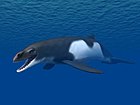| Piscobalaena | |
|---|---|
 | |
| Piscobalaena nana skull | |
| Scientific classification | |
| Domain: | Eukaryota |
| Kingdom: | Animalia |
| Phylum: | Chordata |
| Class: | Mammalia |
| Order: | Artiodactyla |
| Infraorder: | Cetacea |
| Family: | Cetotheriidae G. Pilleri and H. J. Siber, 1989 |
| Genus: | † Piscobalaena G. Pilleri and H. J. Siber, 1989 |
| Type species | |
| †Piscobalaena nana G. Pilleri and H. J. Siber, 1989 | |
Piscobalaena is an extinct genus of cetaceans, which lived from the Middle to Late Miocene epochs (about 11.6 to 5.3 million years ago) in Peru and Florida. [1] Its fossils have been found in the Pisco Formation of Peru and the Bone Valley Formation of Florida. [2] At least some individuals of this diminutive whale were preyed on by the shark O. megalodon . [3]




